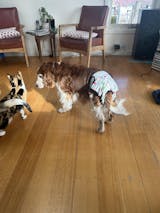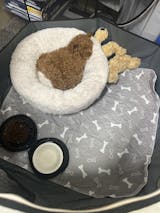How to Prevent Separation Anxiety in Dogs - Causes, Prevention & Protection
When your family leaves the house, your puppy scratches at the door, cries or barks excessively, goes to the toilet in the house, or chews objects, probably puppy separation anxiety is the reason.
Puppies are social animals by nature. Being left alone for a whole workday may come as a disappointment. An elevated risk of separation anxiety is linked to a sudden experience of being alone for an extended period.
It's unclear why some puppies experience separation anxiety while others don't. Whatever the source, it's critical to remember that these actions aren't evil and are most likely panic or other coping mechanisms. Separation anxiety is not resolved by punishing your pet. The ideal method is to acclimate your puppy to being alone gradually. You can start dog separation anxiety training with a professional.

Separation Anxiety in Puppies - What Are They?
When pet parents leave their dogs alone, one of the most common complaints is disruptive or destructive. This can mean your baby has puppy separation anxiety. Their dogs may urinate, defecate, bark, howl, chew, dig, or attempt to run away. These issues are frequently signs that a dog needs to be taught proper house manners, but they can also be signs of grief.
When a dog's troubles are accompanied by additional distress behaviors, such as drooling and displaying worry when his pet parents prepare to leave the house, it isn't proof that the dog isn't house trained or doesn't recognize which toys are to chew. Instead, these are signs of separation anxiety in the dog.
When dogs get distressed as a result of being separated from their owners, separation anxiety develops. Dogs with separation anxiety frequently seek to flee, resulting in self-injury and property destruction, particularly around escape points such as windows and doors.
Signs of Separation Anxiety in Dogs
Before you begin dog separation anxiety training, you must grasp that anxiety, not anything else, is to blame for their conduct. It isn't separation anxiety if a dog barks, chews things, or even pees in the company of his guardian. When a dog's behavior is triggered by separation anxiety, it usually does not occur in the company of his guardian.
Urinating and Defecating: Some dogs urinate or defecate when left alone or apart from their guardians.
Barking and Howling: A dog suffering from separation anxiety may bark or howl. This type of barking or wailing is persistent, and it appears to be unaffected by anything other than being left alone.

Chewing, Digging and Destruction: Some dogs with separation anxiety chew on objects, door frames, and window sills, dig at doors or doorways and destroy household items. Broken teeth, sliced and scratched paws, and damaged nails are all possible outcomes of these activities.
Escaping: When left alone or separated from his guardian, a dog may attempt to flee from an area where he is restricted.
Coprophagia: Some dogs urinate and then eat all or part of their waste. If a dog consumes excrement due to separation anxiety, he most likely does not do it in the company of his owner.

Difference Between Normal Behavior & Separation Anxiety
Starting dog separation anxiety training as soon as diagnosed is a great decision. Separation anxiety is a dangerous issue that extends beyond the occasional melancholy whimper when you go out or the ripped sock that awaits you when you enter. It is not the same as boredom, and unlike a little mischief when your dog is left alone, it results from real worry.
Make sure it's not an issue of insufficient training before categorizing ruined pillows or potty accidents as separation anxiety. Is it true that your dog understands good manners even when you aren't looking? Is he completely potty-trained? Audio or videotaping your dog's behavior while you're gone is one of the finest methods to see what's really going on while you're gone.
What Causes Separation Anxiety in Dogs & Puppies?
There is no substantial proof as to why dogs suffer from separation anxiety. Puppy separation anxiety is thought to be caused by the loss of a valuable person or group of people in a dog's life because considerably more dogs acquired from shelters exhibit this behaviour problem than those raised by a single household since puppyhood. The following is a list of possibilities that have been correlated to the onset of separation anxiety.
Change of Guardian or Family: Separation anxiety can be triggered by being abandoned, surrendered to a shelter, or delivered to a new guardian or family.
Change in Schedule: Separation anxiety can be triggered by a sudden shift in a dog's schedule regarding when or how long they are left alone. If a dog's parent works from home and spends the day with his dog but later takes a new job that forces him to leave his dog alone for a long time, the dog may develop separation anxiety.

Change in Residence: Puppy separation anxiety might occur due to moving to a new location.
Change in Household Membership: Separation anxiety can be triggered by the abrupt absence of a resident family member, whether due to death or relocation.
How to Train a Dog with Separation Anxiety?
As your new puppy adjusts into your home and you begin to form a bond, it's critical to train them for their new lifestyle if you return to work or start spending time away from home. Otherwise, they can suffer from puppy separation anxiety. So now, how to prevent separation anxiety in dogs? We've put together a step-by-step training plan to assist you in teaching your puppy how to be happy and secure on their own.
For young puppies, keep dog separation anxiety training minimal. A few minutes of practice each day can make a big difference. Separations should be a routine part of your dog's day, and you should always work at a level of separation where they don't show signs of discomfort. If your puppy starts to exhibit signs of stress, go back a few steps to when they were still having fun with the procedure.

To Crate Or Not To Crate?
It's worth repeating: a crate is your dog's best friend and ally. It's a valuable training tool and the answer to many puppy problems. When used correctly, it is neither cruel nor unhealthy. Instead, it can offer a safe, peaceful environment for your dog to calm down. Also, crate training for separation anxiety can be beneficial. The key is to get his dog to identify his crate with positive things like chew toys and food-releasing puzzle toys, so he enjoys spending time inside. Some dogs feel safer and more at ease in their crate when left alone. Other dogs, on the other hand, may become frightened. Keep an eye on your puppy's behavior to observe if he calms down or if his anxiety symptoms worsen.
Counter-Conditioning
Show your dog the benefits of being separated. If your puppy is already conditioned to go into stress mode when you leave him, try using a high-value treat that he adores and that you only use for essential lessons and rewards. If you give him a special treat immediately before you leave, he may start to anticipate your departure.

Exercise
Although exercise cannot cure or prevent SA, it can undoubtedly aid its treatment and prevention. To begin, ensure that your puppy receives lots of age-appropriate physical activity. This is particularly true for large, high-activity dogs who have a lot of energy to expend. When you leave, a weary, pleased dog that has had a good walk and some playtime with you is more likely to calm down. Second, don't forget about your puppy's cerebral capabilities. Training sessions, puzzle toys, and cognitive games are all acceptable options. A mental workout may be just as demanding as a physical one, yet it can also be a lot of fun.
Play It Cool
Don't nurture excessive clinginess. Instead, train your puppy to be independent by allowing him to be alone in another room even when you are present. Another technique to combat excessive attachment is to teach a strong stay. Begin with leaving the room for short periods, and once your puppy can stay for many minutes, you can begin to depart. You should eventually be able to leave his sight for five or ten minutes while he waits. It's also crucial to keep your cool when leaving or returning home. You can welcome your dog with affection, but don't be overly sentimental. Instead, maintain a calm and unobtrusive demeanor.
Practice Separations In The Same Room
Dog separation anxiety training is an excellent option. We can suggest an easy training method that you can do without any professional supervision.
If your puppy's safe zone is a room, installing a baby gate at the doorway will allow you to practice the procedures below while keeping your puppy in sight.
- Step outside the puppy enclosure, shout "yes" right away if your puppy stays in the area, and toss a treat away from the enclosure's entrance for your puppy to retrieve. The word "yes" signifies your puppy's accomplishment and informs them that a treat is on its way.
- Wait for them to choose to return to the pen if they follow you out. When they return, say "yes" and toss a goodie to the rear of the room.
- Practice until your puppy has been successful five times in a row, staying in the area and eagerly expecting goodies.

- As long as the puppy remains inside, take a step around the cage or outside the room with the gate open, say "yes," and toss a treat into the space.
- If the puppy comes out, don't give them any treats and wait for them to go back in. Instead, say "yes" and toss a goodie into the area when they return.
- Shut the door for a second, then say "yes" and throw a reward to your puppy away from the door.
- Slowly extend the length of time you are apart after five successful repeats by waiting 2 or 3 seconds before answering "yes."
- Start increasing the distance between you and your dog after your puppy has been happily waiting for around 10 seconds with the door shut between you. Close the door, move away, say "yes" right away, toss a treat to your dog, then return and open the door.
We'll practice at a shorter duration level as we increase distance. Say "yes" and chuck the treat as soon as you take that step away.
Practice with you out of sight
Installing a Wi-Fi-enabled camera in your puppy's secure area allows you to watch for indications of stress when you are away from him. This type of equipment plays a vital role in Dog separation anxiety training.

- Tell your puppy you're leaving by using a consistent indicator cue, such as "I'll be right back," then take a step out of sight, say "yes," and return to toss a reward for them. This alert cue is necessary so that your puppy knows when you leave and does not believe you have misled them.
- Follow the instructions above for building duration while separated in the same room, but with you out of sight.
- Before returning to toss a reward to your puppy, utter the word "yes" while you are still out of sight.
- Note that your puppy may hear you moving around, so start by standing still and out of sight while gradually increasing the duration.
- As your duration increases, provide exciting enrichment for your puppy to participate in while you're gone, so they don't become bored.
- Add in the sounds of you moving about the home and engaging with items once your puppy has spent around 10 seconds alone with you out of sight.
- As you add interruptions, such as the sound of your movement, picking something up and setting it down, opening and closing a door, etc., keep the time short. Otherwise, it can trigger puppy separation anxiety.
Separations with you leaving the house
- At first, add distractions one at a time, then mix them up before saying "yes" and returning to your puppy to give them a treat. Make this enjoyable alone time a part of your puppy's everyday routine!
- Puppy crates should not be left in for longer than four hours at a time.
- Use distractions such as leaving via the front door, locking the door, starting your car, opening and closing the garage door, driving down the driveway, and so on to train your dog to be comfortable alone with you out of sight.

- When practicing with sounds outside the house, say "yes" when you return inside, then return to your puppy and give them a treat.
- Before mixing the sounds, make each sound of you leaving one at a time.
- Maintain proximity to home as you extend your time out of the house, so you can return if your puppy exhibits any indications of stress.
Remember to give your puppy toys and enrichment that you've seen him play with before and that you've considered safe so that he considers alone time as a fun opportunity.
Medications Might Help
Before giving your dog any form of medicine for a behavior problem, always discuss it with your veterinarian or a veterinary behaviorist.

Medication can be highly beneficial, especially in severe cases of separation anxiety. Any separation from their pet parents can cause such distress in some dogs that treatment is impossible without medicines. Anti-anxiety medicine can assist a dog in tolerating some isolation without becoming anxious. It can also speed up the therapy process.
A dog with modest separation anxiety may benefit from medication therapy alone, without behavioral adjustment, in rare instances. Then, with the help of the drug, the dog learns accustomed to being left alone and keeps this new conditioning when he is progressively weaned off the medication. Most dogs, on the other hand, require a combination of medicine and behavior modification.
Additional Tips
- Provide predictability: research suggests that a dog's guardian's reaction has a role in developing separation-related discomfort.
- Respond calmly to your puppy's distress signals. Help them discover methods to avoid what they perceive as terrifying by pairing the experience with pleasant food or play when they encounter things they are afraid of or stressed by.
- Introduce your puppy to various stimuli and couple them with engaging activities and tempting rewards to prevent noise phobias, often connected with separation anxiety.
- Avoid corrections or punishment by rewarding positive behaviors, refocusing your puppy, and controlling their environment, so they don't engage in undesirable behaviors.
- When you leave, play soothing music for your puppy to reduce the intensity of outside noises and create a relaxing environment.
You can help your puppy grow up to be confident and independent by developing a schedule for them that includes daily alone time. Most essential is having a great time with your puppy while still enjoying your time apart!
Our Products that can Help You with Separation Anxiety
Dry Paws is Australia's one of the most trusted sites for dog products. So definitely, we have items for puppy separation anxiety.
Snuffle Mat: What will your dog do in the crate in the training period? Snuffle mat by Dry Paws is made from high-quality, safe, non-toxic, and wear-resistant to bite fabric. Just put their favorite treats into the fingers and enjoy your time alone.
Playpen: You can use a playpen by Dry Paws for crate training to reduce puppy separation anxiety. It provides more space for the dog than a traditional crate. So you can put water and food bowls, pee pads, toys etc.
Puppy Training Pads: When confined in a small place, it is better to use a pee pad than soil it. We provide the best quality pee pads that are multilayer structured to absorb everything. The pads are machine-washable and reusable.
Dogs Cooling Mat: The cooling mat helps dogs to calm down. So it can be a crucial element for your puppy separation anxiety. In addition, it is scratch-resistant, so your dog won't be able to puncture it.
Click to Buy
Dog Diapers: Even if you have a pee pad, it is better to use diapers for a longer period. If you're training a puppy, then they can get anxious fast. It can cause unintentional peeing. Our diapers are comfortable but strong, so your dog's skin won't be irritated.
Our Final Words
Despite your best efforts, separation anxiety in puppies and dogs is not always curable. But proper dog separation anxiety training can reduce the suffering. Consider hiring a Certified Applied Animal Behaviorist or a veterinary behaviorist to assist with the transition. Despite how terrible this ailment is, it has a high therapeutic success rate. You might be able to alleviate your dog's suffering and put puppy separation behind you if you have patience and a positive mindset.
Puppies should have plenty of opportunities to interact with other animals and people. Puppies must learn to spend time alone and entertain themselves with their toys. Make sure you only take your puppy out of his alone time to interact with the family while playing with his toys.
Follow our tips wholeheartedly; it may help you more than you realize. However, one thing that I'll always say is do not punish your dog. Whatever the situation is, whether a training failure or mischief, punishing or scolding can make them afraid of you. You won't like it, right? So deal with them patiently.




















